This writing business was a significant learning curve for me, and I suspect, for others as well. Few authors stepped into it fully capable and informed on every aspect of our chosen careers. I’m fear you’ll see some letdowns as you gain experience, but be prepared.
There were great successes at the outset when I published my first newspaper column in 1988, but before that I suffered a list of minor and major disappointments that sometimes almost made me throw my hands in the air and give up.
I wish I hadn’t thrown away a box full of decades-old rejection slips and letters back around 2000, when I was at a low point in my sputtering career as a novelist. I was ready to chuck it all one day, soon after my newspaper column was on the brink of national syndication through King Features, who discovered that I was self-syndicated in more than 50 papers in Texas and Oklahoma. However, that new beast called the Internet sucked the life out of newspaper publishing, and the first thing managers did was drop columnists.
So from that high point, I went to three papers where the columns remain to this day.
Big Disappointment Number 1
Instead of being the “Outdoor Dave Barry,” as a King Features agent called me, I was almost back to square one when they called to say thanks, but no thanks now, and good luck. Feeling sorry for myself, I opened that box of rejection slips and read them one by one.
Many were from Readers Digest in the late 1960s Another was a single sentence typed in 1969 under Playboy letterhead to a 16 year-old kid, “Thank you for your submission, but it does not meet our needs at this time.” Encouraged that there was a coffee stain on one of the submissions (somebody read it, huzzah!), I continued pelting them with submissions through the next few years, there were many more from that magazine.
Other rejection slips came from outdoor periodicals, national magazines, large daily newspapers, and finally, book publishers. At first I considered those polite but milquetoast rejections as a form of encouragement (somebody was actually reading my efforts), but sitting in the hot attic on that low-point day, they mocked my attempts to be published.
When the columnist market collapsed and my papers dropped off at an alarming rate, I had to start writing how-to “hook and bullet” articles for outdoor magazines in order to keep my name out there. Those photo/copy packages paid well, but they took a tremendous amount of time and research to produce, so I looked around to find a bigger brick to throw.
It had been right there in front of me for years. I had to write a novel.
In the late 1970s, I hammered on a Smith Corona portable typewriter, then migrated to the new technology of a 1980s-era IBM Selectric nestled on a makeshift desk in the second tiny bedroom/library/office of my 900-square foot frame house. There I started half a dozen novels that fizzled out by page 40. They simply wouldn’t hold even my interest, let alone others.
One is still in a drawer. Titled Smoke and Ash, it’s an unreadable apocalyptic draft and I only keep it in a file to occasionally torture myself and remember how it was.
I experimented with humor, science fiction, and short stories. My frustration was that I constantly needed to go back and correct typos, or insert ideas and dialogue that came to me later.
My soul was freed when I bought a 286 computer. It didn’t take long, but I figured out how to write on a Sperrylink word program and the words flowed.
Big Disappointment Number 2
Then one day I began The Rock Hole and when it was finally finished years later, I hit the save key one final time, only to find that the dinosaur word program’s 5½ inch floppy disk wouldn’t hold so much information and overwrites. It malfunctioned and the entire work disappeared in a technological burp.
I had to re-write the entire manuscript from memory, but I like to think it was better than the original. With document saved this time on a Zip drive, I submitted that new manuscript to a number of publishers. Most said thanks, but no thanks, but a Texas university press was interested in the novel, and here’s where I screwed up.
Big Disappointment Number 3
Remember, I was green as grass, and hadn’t even spoke to more than two or three writers by then, so I wasn’t sure what to expect when the editor at that time communicated with me via old school letters at first, suggesting edits and offering encouragement. I did some more editing, sent it, and she asked for the manuscript.
I printed and mailed her the 140,000 word manuscript of what was then titled Center Springs, Texas, and waited. Yeah, I know it was way too long…now. The first hundred pages came back from a copy editor, with a list of problems. That individual picked the manuscript apart, much like a high school English teacher, and it looked as if she’d been in the process of turning into a werewolf at the same time she read it. The pages bled red ink, scalding comments, and I swear there were claw marks across some of them.
That individual wasn’t good at stroking writers. It seems she hated such repeated words as old, real, porch, and just, that I’d used over and over. I recall a number of suggestions and ways to tightened the work, and so I threw those pages on still another makeshift desk and gave up.
I gave up on an editor at that university press who was interested in publishing that work long before it was picked up in 2010 under a different name by Poisoned Pen Press. In essence, I didn’t know they were on the verge of accepting it for publication. I still slap my head in my sleep, when dreams arise and I see those communications from them in the trash.
Looking back, though, I guess it was a good thing I didn’t go with the university press, because that would have likely been a one-book deal. Instead, Poisoned Pen offered me a series that continues to this day.
Big Disappointment Number 4
That wasn’t the end of letdowns for me, though. Not by a long shot. A production company that had finished filming Winter’s Bone liked The Rock Hole, and called me direct to offer a movie deal!
However, my starter agent (which I fired not long after that offer) started playing games with the company and they quickly threw up their hands and backed away from the project.
But I had the Red River series with Poisoned Pen, and found an excellent agent who was experienced in the publishing world. Together, we worked on a second series that was picked up by Kensington. Frustrations faded to memories and I was a busy guy for a while, and still am, but I wanted to do something different.
Through friends who are bestselling authors, I heard about an up and coming eBook publisher that was looking for something different. They arranged for a face to face meeting at a conference in Colorado. I drove up, met the publisher, and we went out to dinner.
Big Disappointment Number…oh, what the hell.
The next day he agreed to publish something completely different for me, a weird western that he loved. We shook on it, with the promise from him to contact my agent and hammer out a contract.
Two days later, he crawfished on the deal with a lame excuse I won’t write here, and refused to take calls or emails. I was raised by people who survived the Great Depression, World War II, and fickle weather, and grew up with the absolute understanding that a handshake was a legal bond, a man’s word.
Apparently, he didn’t see it that way, and that series evaporated into the wind, but it didn’t stop me. Why? Because I refuse to give up and give in to setbacks.
Now, get back on that horse and ride.
If you continue on the path to being an author, you’re likely to ride that rollercoaster of highs and lows, it’s simply part of the business. But remember, never let ‘em show you’re wounded, and never, ever, give up.
Good luck and happy typing.

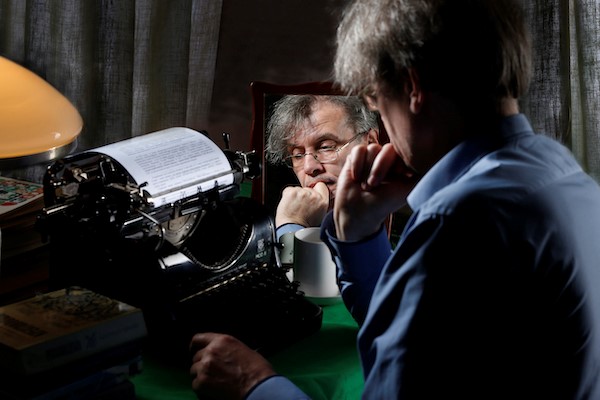



 My world no longer looks like an Impressionist painting. I can see individual leaves on trees, blades of grass, street signs (oh, that’s where I was supposed to turn).
My world no longer looks like an Impressionist painting. I can see individual leaves on trees, blades of grass, street signs (oh, that’s where I was supposed to turn).